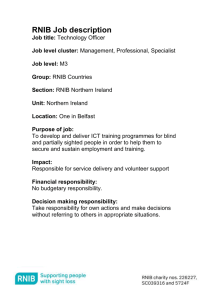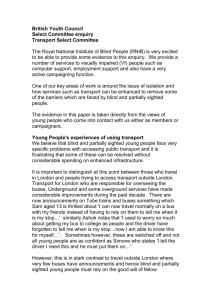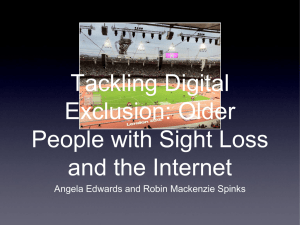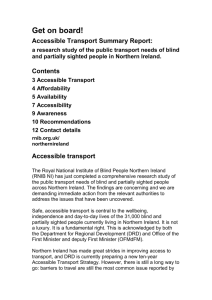Designing gardens and nature trails factsheet
advertisement
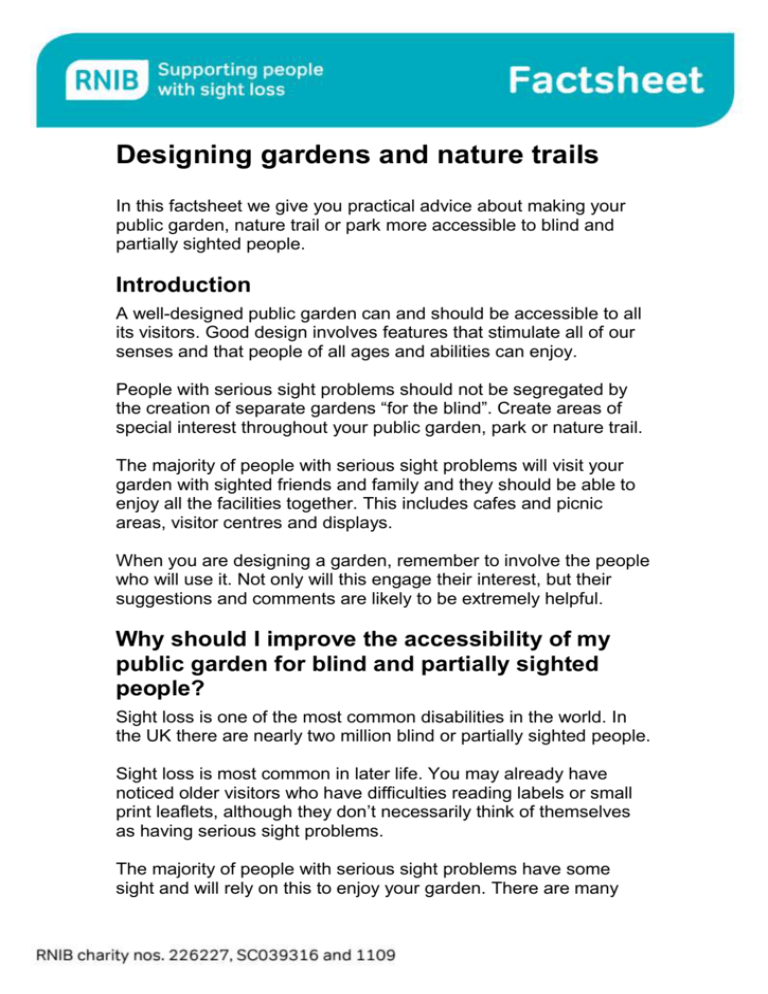
Designing gardens and nature trails In this factsheet we give you practical advice about making your public garden, nature trail or park more accessible to blind and partially sighted people. Introduction A well-designed public garden can and should be accessible to all its visitors. Good design involves features that stimulate all of our senses and that people of all ages and abilities can enjoy. People with serious sight problems should not be segregated by the creation of separate gardens “for the blind”. Create areas of special interest throughout your public garden, park or nature trail. The majority of people with serious sight problems will visit your garden with sighted friends and family and they should be able to enjoy all the facilities together. This includes cafes and picnic areas, visitor centres and displays. When you are designing a garden, remember to involve the people who will use it. Not only will this engage their interest, but their suggestions and comments are likely to be extremely helpful. Why should I improve the accessibility of my public garden for blind and partially sighted people? Sight loss is one of the most common disabilities in the world. In the UK there are nearly two million blind or partially sighted people. Sight loss is most common in later life. You may already have noticed older visitors who have difficulties reading labels or small print leaflets, although they don’t necessarily think of themselves as having serious sight problems. The majority of people with serious sight problems have some sight and will rely on this to enjoy your garden. There are many different eye conditions that affect people in different ways: some people can only see a narrow field in front of them (tunnel vision); others may have side or peripheral vision. Improvements for people with serious sight problems should therefore form part of your overall policy for making your site accessible to all. Improvements such as clear signage, unobstructed pathways and multi-sensory displays will benefit all of your visitors. Visual awareness training RNIB can organise tailor-made training to help your venue welcome people with serious sight problems. Our training will raise awareness of blind and partially sighted people demonstrate what you can do to help and discuss how you can organise your services more effectively to meet the needs of people with serious sight problems. Visual awareness training is most effective where there is already a commitment to access and a clear policy in place. Designing gardens and nature trails Footpaths – materials and recommended maintenance The surface material of footpaths should be firm, well fixed, slipresistant and slightly textured (eg Binding Path Gravel or Asdug, Fibredec). Loose materials such as gravel are not suitable. Continual maintenance is essential and you should keep paths well drained to prevent puddles. Where you have stapled a material such as plastic-coated wire mesh to boardwalks or small bridges to improve grip, you should regularly inspect it to ensure that it remains flush with the decking and does not become a hazard. We recommend that you use a contrast in colour, tone and texture between footpaths and their surroundings. You can also use contrasts in surface material to convey information to blind, deafblind and partially sighted people. This is particularly useful where signposts are inappropriate. For example, you could surface side paths leading to features of special interest with different 2 textures. Textural changes can be used to convey specific messages; eg to indicate the location of a tactile signboard. Blind and partially sighted visitors may appreciate variations in surface texture as an added interest on a walk in the countryside. When adding new surface materials, take care to ensure that changes in surface are flush, and joints between materials are no wider than 10mm. Handrails Where footpaths follow a gradient, provide a continuous handrail and a lower “tapping” rail (at 150-200mm above ground level) that someone using a long cane can follow. If a handrail is not acceptable for aesthetic reasons, try installing a small kerb, minimum 100mm high. Handrails are essential on both sides of routes that pass over footbridges and you should provide railings where paths run adjacent to dangerous areas. Once you have provided a handrail, users will lean against it, so you must ensure it is strongly supported and that you maintain it regularly. Steps Eliminate steps wherever possible, as they are unsuitable for wheelchair users and people with serious sight problems. Where steps are unavoidable, use a change in surface texture before the steps to indicate them in advance, and have continuous handrails on both sides. Steps should have a uniform going and riser wherever possible. Minimum going is 250mm, maximum riser is 170mm. Avoid open risers, and nosings should be of a contrasting colour and tone to the rest of the step. Managing hazards Use surface materials to indicate the presence of hazards; for example, you could lay (flush) an area of granite paving blocks across a path a metre or two before a road or steps, to warn of the potential danger. You could link this to a raised-letter tactile sign, or to a sequence on a carried tape recorder, or to a passage in a braille leaflet, giving information on the feature ahead. 3 Place picnic tables, litterbins and other furniture in recessed (but still accessible) areas, so as not to create a hazard. All furniture should be a minimum height of 1000mm, colour and tone contrasted with the background, and detectable at ground level by a person using a long cane. It is useful to have space around seating for people to position wheelchairs or pushchairs. Don’t forget garden maintenance. A neglected garden quickly loses its appeal and interest, and the special features created originally become confused. A badly maintained garden can also be dangerous. Keep your paths, steps, ramps and signs clear of debris, obstructions, creeping plants and protruding roots. Look out for obstacles above waist height, since blind or partially sighted people may miss these if they are using a long cane or a guide dog. Cut back tree branches and other foliage to ensure minimum clear headroom of 2100mm, preferably 3000mm. Planting Have a think about making the most of people’s senses when you consider your planting scheme. Planting design that emphasise colour and aroma will be of great benefit to your blind or partially sighted visitors, being both a source of pleasure and a way of finding information. Don’t overlook the smell of newly mown grass or plant leaves, which can release perfume when touched. We give a list of some fragrant garden plants later in this factsheet. Touch in the garden is very important. Try selecting plants for different textures of leaves, bark and stems, as well as the shape of the whole plant. Some plants also give off a scent when crushed or stroked. When choosing them, be aware of their durability and strength as some will not stand up to much examination. Most importantly, avoid plants with thorns and those that have sap that might irritate. Stones or rocks can also provide interesting textures. Another idea is a small interpretation centre where you can encourage your visitors to feel the texture and shapes of items. 4 The sounds of a garden give pleasure to everyone – birds with their varying calls, the breeze rustling in beech, hornbeam, bamboo or other plants, wind chimes, water falling and running over different resonant surfaces in a fountain. Sound also helps to provide a sense of perspective – a fountain playing in the distance, for instance, sounds different from a fountain splashing near at hand. Water that creates too loud a sound can drown out other natural sounds like birdsong and cause problems for people with hearing impairments. Safe access to water should be available for those who wish to dip their hands in, perhaps also bordered with smooth stones or pebbles. Large dry boulders are pleasing, especially when warmed by the sun. Providing information You can provide information in a variety of ways. You could provide a descriptive audio tour device at the entrance or a tactile map for loan by people with serious sight problems. A guide or map should include the position of points of interest, amenities such as seats or toilets or a café. You should also include information about footbridges, steps and other potential hazards. Audio tours can be useful, but at outdoor sites they will cut out sounds such as bird song. Listening posts at selected points throughout your garden or trail could be a useful alternative. You might also like to prepare a CD or upload an audio file to your website, which you could mail to visitors in advance as a useful introduction. Labelling plants can sometimes be a problem. A board by the path, which could be read at close range, should list the plants and shrubs in that bed. Number the names on the board and ensure that they correspond to numbers next to the plants. The lettering on the board should be large and bold, using black letters on a white background and the signs by the plants should be even larger. Braille is read by very few people so is not suitable on its own; however the bold lettering can be overlaid by a transparent brailled label. 5 It is possible that embossed letters on the board near the path might be useful. Embossed numbers on a bed are unlikely to be useful, firstly because they might not be easily accessible, and secondly because they could become clogged by grit. You could describe the labelling scheme on an audio guide or information leaflet handed out at the entrance to the garden. Leaflets and guides should be accessible to people with serious sight problems. The majority of people with serious sight problems can read large print. You can produce this on standard word processors by enlarging the font size and following clear print guidelines. Think about including information on facilities for disabled people on your publicity materials. Sighted visitors may well have relatives, neighbours or friends with serious sight problems who they can tell about your services. It will be useful if you include information such as concessionary rates for disabled people, whether guide dogs are admitted to all areas of your garden, as well as details on facilities and services (eg raised diagrams, large print and or braille labels, audio tours, guided tours). Finally, ensure that your information addresses people with disabilities in a positive way and avoid terms such as “the blind”; think about using the term “blind or partially sighted people” instead. Reaching your audience If you develop an accessible garden for people with serious sight problems, you will want to make sure that your target audience hears about it! The majority of visitors will come with sighted friends and family so do include access details in all your general publicity materials. Information does not reach blind or partially sighted people easily. A good place to start is by establishing links with local societies for blind and partially sighted people and self-help groups in your area. Local contacts will prove invaluable in disseminating information and may also provide useful advice and feedback. 6 Have a look on the Sightline Directory (www.sightlinedirectory.org.uk) to find details of organisations near you. Some fragrant garden plants to try Codes: “W” signifies best grown against a wall “E” signifies an evergreen species “cvs” means cultivars (plant varieties) “spp” means species. Flowers Trees Acacia dealbata – “Mimosa”. Yellow flowers in late winter, early spring (W E) Azara microphylla. Vanilla-scented yellow flowers in early spring (E) Crataegus monogyna – “Hawthorn” Drimys winteri – “Winter Bark”. Ivory-white flowers in May (E) Magnolia salicifolia. Flowers produced on leafless stems in April Prunus – especially padus, yedoensis and several “Japanese Cherries” Tilia x euchlora, petiolaris, platyphyllos ‘Rubra’ – “Lime”. Shrubs Azalea – see Rhododendron Buddleia alternifolia, davidii and cvs. (attractive to butterflies) Buxus sempervirens – “Common Box” (E) Chimonanthus praecox – “Winter Sweet”. Waxy yellow flowers Choisya ternata – “Mexican Orange Blossom” (E) Clerodendron bungei, trichotomum – Foliage smells foetid when bruised Clethra spp. – all Coronilla glauca (W) Corylopsis spp – spring flowering Cytisus battandieri (pineapple fragrance), x praecox Daphne blagayana, x burkwoodii, cneorum, mezereum, odora (E) 7 Deutzia x elegantissima and cvs. Elaeagnus angustifolia, commuta, x ebbingei (E), umbellata Erica arborea, x darleyensis and cvs, erigena (mediterranea), lusitanica (E) Escallonia – “Donard Gem” (E) Genista aetnensis, cinerea, tenera Hamamelis mollis and cvs. – “Witch Hazel” Itea ilicifolia (E) Lonicera fragrantissima x purpusii, standishii – Winter flowering shrubby honeysuckles Magnolia denudata, grandiflora (W, E), sieboldii, stellata, x soulangiana and cvs. Mahonia japonica, x media and cvs (eg “Charity”, “Faith”, “Underway”) (E) Olearia x haastii, macrodonta (E) Osmanthus x burkwoodii, delavayi, heterophyllus (aquifolium) (E) Philadelphus esp. “Belle Etoile”, “Beauclerk”, coronarius Philadelphus delavayi, microphyllus, “Sybille”, “Virginal” – “Mock Orange” Phillyrea decora (E) Poncirus trifoliata – “Japanese Bitter Orange”. Flowers and small fruits like the orange Prunus mume – “Japanese Apricot”. Early spring flowering Ptelea trifoliata – Bark, leaves and fruit also aromatic Pyracantha – Many spp. and cvs (E) Rhododendron – Many, especially auriculatum, loderi and its many clones, luteum, roseum, viscosum; and deciduous Azaleas (Ghent and Occidentale hybrids) Romneya spp. – Californian “Tree Poppies” Rosa – see Royal National Rose Society’s list - R. alba, Bourbons (Zephirine Drouhin), Damasks, double Moss, rubiginosa and some Rugosas Sarcococca – all – “Christmas Box”, winter flowering (E) Skimmia japonica – male flowered forms, especially the cvs. “Fragrans” (E) Spartium junceum – “Spanish Broom” Syringa – “Lilac” Virburmum x bodnantense, x burkwoodii, x carlcephalum, carlesii, farreri, (fragrans) – spp. usually flowering in winter or late spring. 8 Climbers and wall shrubs Clematis armandii, montana “Elizabeth”, rehderiana (nodding yellow bell-shaped flowers) Jasminum officinale – “Common White Jasmine”. A strong growing climber Lonicera x americana, japonica and cvs., periclymenum and cvs. – “Honeysuckle” Trachelospermum jasminoides – requires a warm sheltered site (E) Wisteria floribunda, sinensis – many good cvs. of each Hardy herbaceous Asperula odorata – “Sweet Woodruff” – grows well in shade Chrysanthemum balsamita Clematis heracleifolia var. davidiana, C. recta Convallaria majalis – “Lily of the Valley” Dianthus (particularly “Border Carnations” and “Pinks”) Hedychium – Many spp. require greenhouse culture Hemerocallis dumortieri, flava – “Day Lilies” Hosta “Honeybells”, plantaginea grandiflora Iris unguicularis (stylosa) Paeonia officinalis, lactiflora Phlox paniculata (hybrids) Primula auricula, veris, florindae, polyanthus Viola odorata – “Sweet Violet” Annuals and biennials Centaurea moschata – “Sweet Sultan” Cheiranthus – “Wallflower” Heliotropum – “Heliotrope”, “Cherry Pie” Lathyrus odoratus – “Sweet Pea” Lobularia maritima – “Sweet Alyssum” Matthiola – “Stock” Nicotiana affinis, sylvestris – “Tobacco Plant” Oenothera biennis – “Evening Primrose” Reseda Odorate – “Mignonette”. Bulbs and coms Amaryllis belladonna (W) Crinum x powellii (W) Cyclamen 9 Freesia Gladiolus tristis Hyacinthus Iris reticulata and cvs. Lilium. esp. euratum, longiflorum, regale, speciosum Narcissus (Jonquil, Poeticus and Tazetta groups) Tulip. Glasshouse and conservatory plants Boronia megastigma Bouvardia humboltii, jasminiflora Brunfelsia spp. Buddleia asiatica Citrus spp. Cytisus canariensis, “Porlock” Dianthus – “Malmaison and Perpetual Carnations”, usually tender Erica canaliculata Exacum affine – “Persian Violet”. Annual Gardenia spp. - especially G. jasminoides Hoya bella, carnosa – “Wax Flowers” Ismene spp. Jasminum polyanthum Primula kewensis Plumeria spp. – “Frangipani” Polianthes tuberosus Rhododendren – tender spp/hybrids eg x cubittii, “Fragrantissimum” Stephanotis floribunda. Foliage Trees Eucalyptus – many different spp. (E) Laurus nobilis – “Bay”, well known in cooking (E) Magnolia salicifolia (bark) – wood and twigs scented of lemon Populus balsamifera, trichocarpa – unfurling leaves smell of balsam Sassafras albidum – leaves, bark and twigs fragrant. 10 Shrubs Artemisia abrotanum, chamaemelifolia Ballota acetabulosa – not fully hardy Calycanthus floridus – “Carolina Allspice” Caryopteris – all Choisya ternata – “Mexican Orange Blossom” (E) Cistus – many spp., especially those with leaves covered in gum (C. ladanifer) Drimys lanceolata (aromatica) (E) Escallonia – Several (E) Gaultheria procumbens – source of “Oil of Wintergreen” (E) Helichrysum serotinum (angustifolium) – “Curry Plant” (E) Lavandula angustifolia (spica) – “Old English Lavender” Lindera benzoin – “Spice Bush” Lippia citriodora – “Lemon Verbena” Myrica communis – “Myrtle” (E) Perovskia spp. and cvs. – late flowering sub-shrubs Ribes sanguineum – “Flowering Currant” Rosa rubiginosa and hybrids – “Sweet Briar”. Apple scented leaves. Rosmarinus officinalis – “Rosemary” (E) Sallvia officinalis – “Sage”. Plus several other half-hardy spp. Santolina spp. – “Lavender Cotton” (E) Skimmia laureola (E) Thymus spp. – especially T. x citriodorus “Lemon Thyme” and E T. herba-barona “Caraway Thyme” Conifers Abies balsamina (E) Calocedrus decurrens – “Incense Cedar” (E) Chamaecyparis (E) Cupressus sempervirens (E) Juniper (E) Pseudotsuga menziesii – “Oregon Douglas Fir” (E) Thuja (E). Herbaceous Achillea millefolium – “Yarrow”. A. filependulina “Gold Plate” Agrimonia odorata, eupatoria – has the scent of ripe apricots Angelica archangelica – the source of confectionery angelica 11 Anthoxanthum odoratum – “Sweet Vernal Grass” Calamintha nepetoides Chamaemelum nobile – “Chamomile” Geranium macrorrhizum Melissa officinalis – “Lemon Balm” Mentha – many spp. with different scents – “Mint” Monarda didyma – “Bergamot” Nepeta spp. – foliage sometimes rather pungent – “Catmint” Origanum vulgare – “Marjoram” Stachys lanata – “Lamb’s Ears”. Bark and branches Acer pensylvanicum – “Snake Bark Maple” Betula “Jermyns” – “Paper Bark Birch” Corylus avellana “Contorta” – Hazel with twisted branches Prunus Mackii – Cherry with peeling bark Salix matsudana “Tortuosa” – “Dragons Claw Willow”, twisted branches. This list is based on information provided by RHS Wisley. Useful contacts RNIB business services Our business services team aims to help create an inclusive society through improved access for all disabled people to environments and services. We provide our leading access consultancy covering access for disabled people to buildings, streets and transport; accessibility of products, information, signage, tactile images, tactile maps and wayfinding, including the RNIB React electronic wayfinding device. We also offer a range of training courses, from disability or visual awareness through to technical courses on subjects such as visual contrast, lighting and signage. For more information please visit www.rnib-business.org.uk or call us on 01733 375 370. You can also email businesslink@rnib.org.uk. 12 Fieldfare Trust Fieldfare works with people with disabilities and countryside managers to improve access to the countryside for everyone. Their Advisory Services team can help with access audits on countryside sites; planning and promoting accessible countryside events to people with disabilities; and preparing interpretive leaflets, display boards and guided walks for people with sensory impairments. info@fieldfare.org.uk www.fieldfare.org.uk The Sensory Trust The Sensory Trust works to ensure that all people, regardless of mental, physical or sensory disability have the right to experience, learn from, enjoy and actively participate in the environment. The Sensory Trust, c/o Eden Project, Bodelva, Cornwall, PL24 2SG t: 01726 222 900 enquiries@sensorytrust.org.uk www.sensorytrust.org.uk Thrive Thrive is a national charity that uses gardening to change the lives of disabled people and they helped to produce the original version of this factsheet. The Geoffrey Udall Centre, Beech Hill, Reading RG7 2AT t: 0118 988 5688 info@thrive.org.uk www.thrive.org.uk and www.carryongardening.org.uk Useful publications How to guide people with sight problems A guide to assist those in offering to help blind and partially sighted people with confidence. Order from our Helpline by calling 0303 123 9999. 13 By all reasonable means: inclusive access to the outdoors for disabled people (CA215) This guide, produced by Natural England, is designed to help countryside and urban greenspace managers and landowners improve accessibility of their sites, routes and facilities. It focuses on work with and for disabled people, but with the understanding that many access improvements will benefit all visitors. The framework for action in this guide is appropriate for most types of outdoor space open to the public including: country and urban parks and green spaces long distance and other trails, paths and rights-of-way the wider countryside, including open access land. Order or download free from: http://publications.naturalengland.org.uk/publication/45015 For general enquiries to Natural England, call 0845 600 3078 or email enquiries@naturalengland.org.uk. RNIB Research Library A number of other relevant publications are available from the RNIB Research Library, part of RNIB Heritage Services. The Research Library is the largest collection of material on blindness and partial sight in the UK. Loan facilities are available in the UK and Eire. 105 Judd Street, London, WC1H 9NE t: 020 7391 2052 researchlibrary@rnib.org.uk rnib.org.uk/researchlibrary Updated November 2015 14
